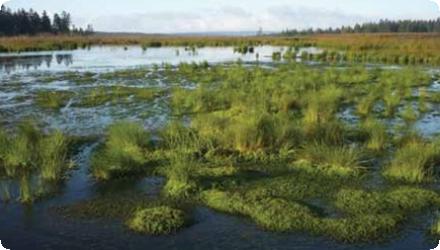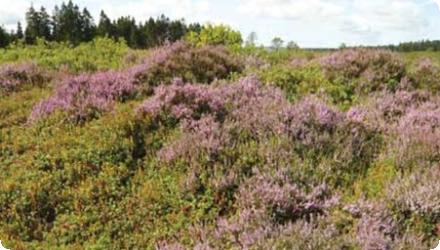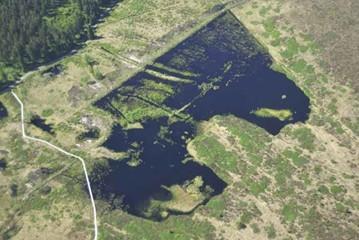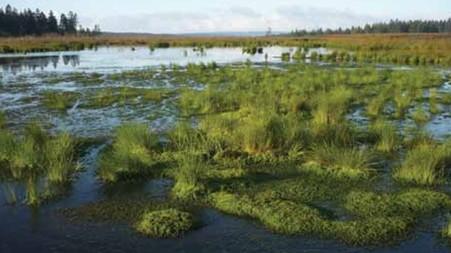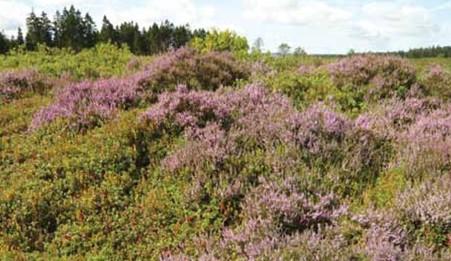Last update
2024
Summary
The project to rehabilitate heaths and mires on the Hautes-Fagnes Plateau (Belgium) is a long-running peatland restoration programme. A LIFE project (2007–2012) initiated large-scale works and the effort has continued since 2012, with additional operations funded mainly through the Walloon Rural Development Programme (PwDR). The 2007–2012 LIFE achievements were:
• 137 ha of private land purchased, restored and designated as nature reserves (RND);
• 208 ha of public land restored and designated as RND;
• 362 ha of municipal and private land restored under conservation agreements;
• 712 ha of spruce plantations on peat/peaty/hydromorphic soils cleared;
• 259 ha of dense spruce regeneration removed on former clear-cuts on peat/peaty/hydromorphic soils;
• 178 km of drainage ditches neutralized (peat/clay plugs every 25–30 m);
• 4,519 ponds created (~20 ha);
• 23 ha of degraded peatlands restored through rewetting;
• 157 ha of degraded peatlands restored through topsoil removal;
• 94 ha of (mainly peaty) heath restored through sod-cutting;
• 50 ha of heath/peat/meadows/Nardus grasslands restored by restorative mowing;
• 373 ha of heath/peat fenced for grazing;
• 124 ha of clear-cuts fenced to promote natural regeneration of deciduous trees;
• 98 cryoturbation features (lithalsas) repaired;
• 8 ha of stripped peatlands revegetated (shredded Sphagnum, cotton-grass planting);
• 1,540 ha of heath/peat cleared of natural tree seedlings (mostly conifers);
• 22 ha of non-native deciduous trees (Alnus incana) removed.
Since 2012, restoration under PwDR has progressed across many sites (e.g., Misten, Fagne Wallonne, Cléfaye, Fagne des Wés, Potales, Fagne de la Poleûr, Helle & Soor valleys, Brackvenn North, Grande Fange, Geitzbusch). Official updates indicate that, to date, ~348 ha of high bogs in the High Fens have been treated using two main techniques - rewetting by engineered bunds/dams (~97 ha) and large-scale topsoil removal/decapage (~251 ha) - with ongoing works in several sectors (monitoring shows positive vegetation trajectories and higher drought resilience in restored plots). Technical practice has evolved from drain-blocking alone to extensive decapage (typically 20–40 cm to remove mineralised peat and Molinia tussocks) and managed re-inundation; the use of excavators operating on modular rafts minimizes substrate damage and enables work in very soft peat. Beyond habitat works, the site has also hosted species-focused actions (e.g., the black grouse reinforcement programme led by ULiège/RBINS/DNF).
Broader recognition and governance: the LIFE project PLTHautes-Fagnes received the “Best of the Best” LIFE Nature award (2013). According to LIFE/Ramsar sources, project actions have restored on the order of ~2,800 ha of degraded heath and mires and contributed to increases in certain breeding bird populations. After-LIFE management is led by the Walloon public services (SPW-DEMNA/DNF) with partners, and complementary landscape-scale actions are running in the wider Ardennes (e.g., LIFE “Vallées ardennaises”, 2020–2028), supporting riverine and forest processes connected to the peatland hydrology.
• 137 ha of private land purchased, restored and designated as nature reserves (RND);
• 208 ha of public land restored and designated as RND;
• 362 ha of municipal and private land restored under conservation agreements;
• 712 ha of spruce plantations on peat/peaty/hydromorphic soils cleared;
• 259 ha of dense spruce regeneration removed on former clear-cuts on peat/peaty/hydromorphic soils;
• 178 km of drainage ditches neutralized (peat/clay plugs every 25–30 m);
• 4,519 ponds created (~20 ha);
• 23 ha of degraded peatlands restored through rewetting;
• 157 ha of degraded peatlands restored through topsoil removal;
• 94 ha of (mainly peaty) heath restored through sod-cutting;
• 50 ha of heath/peat/meadows/Nardus grasslands restored by restorative mowing;
• 373 ha of heath/peat fenced for grazing;
• 124 ha of clear-cuts fenced to promote natural regeneration of deciduous trees;
• 98 cryoturbation features (lithalsas) repaired;
• 8 ha of stripped peatlands revegetated (shredded Sphagnum, cotton-grass planting);
• 1,540 ha of heath/peat cleared of natural tree seedlings (mostly conifers);
• 22 ha of non-native deciduous trees (Alnus incana) removed.
Since 2012, restoration under PwDR has progressed across many sites (e.g., Misten, Fagne Wallonne, Cléfaye, Fagne des Wés, Potales, Fagne de la Poleûr, Helle & Soor valleys, Brackvenn North, Grande Fange, Geitzbusch). Official updates indicate that, to date, ~348 ha of high bogs in the High Fens have been treated using two main techniques - rewetting by engineered bunds/dams (~97 ha) and large-scale topsoil removal/decapage (~251 ha) - with ongoing works in several sectors (monitoring shows positive vegetation trajectories and higher drought resilience in restored plots). Technical practice has evolved from drain-blocking alone to extensive decapage (typically 20–40 cm to remove mineralised peat and Molinia tussocks) and managed re-inundation; the use of excavators operating on modular rafts minimizes substrate damage and enables work in very soft peat. Beyond habitat works, the site has also hosted species-focused actions (e.g., the black grouse reinforcement programme led by ULiège/RBINS/DNF).
Broader recognition and governance: the LIFE project PLTHautes-Fagnes received the “Best of the Best” LIFE Nature award (2013). According to LIFE/Ramsar sources, project actions have restored on the order of ~2,800 ha of degraded heath and mires and contributed to increases in certain breeding bird populations. After-LIFE management is led by the Walloon public services (SPW-DEMNA/DNF) with partners, and complementary landscape-scale actions are running in the wider Ardennes (e.g., LIFE “Vallées ardennaises”, 2020–2028), supporting riverine and forest processes connected to the peatland hydrology.
Position
Latitude
50.5
Longitude
6.0833333
Project
NWRM
National Id
Belgium_01
Installation date
2007-01
Implementation Status
Contact
Alexandra Rossi, ACTeon
RBD code
BEMeuse_RW
Transboundary
0
Photo gallery
Location of the project
The project is located in the Hautes Fagnes in the Ardennes.
NUTS Code
BE33 - Prov. Liège
Project's objectives
Restore ~1,400 ha of peaty/wet habitats; abandon spruce on ~630 ha; regenerate ~400 ha of birch-oak woodland; extensive ditch blocking, pond creation, rewetting and topsoil removal/sod-cutting to re-establish bog/heath processes.
Involved Partners
| Authority type | Authority name | Role | Comments |
|---|---|---|---|
Climate zone
cool temperate moist
Temperature
6
Precipitation
1439
Annual rainfall range
900 - 1200 mm
Imperviousness range
0 - 10%
Elevation range
671 m
Slope range
< 5 % for restored areas
Vegetation class
Either classic moorland, peat bog, or even peat forest vegetation. Conifers and spruce trees are present but removed during the restoration work.
Water bodies: Ecological Status
Good
Water bodies: Chemical Status
Failing to achieve good
Water quality status
Water is acid, dystrophic and pollution free. There are specific problems related to organic pollution around the Michel-Baraque, of the Rigi mont and of the Botrange. There is eutrophication along the road crossing the haute Fagnes (due to snow removal).
Project scale
Large
Project scale specification
6 Natura 2000 areas
Performance timescale
> 20 years
Project area
14000
Area specifications
The area of the rehabilitation is 1400 ha and is located upstream, in the Ardennes mountains. The application will impact a downstream area.
Area subject to Land use change or Management/Practice change (ha)
500
The main idea was to continue the restoration of the heaths and mires area in the Walloon region. It started 5 years ago (Saint Hubert, Croix Saille and Tailles plateau projects). Restoration methods have been developed in the region for 20 years.
Design capacity description
The project was not designed for its water retention capacity. Although, about 8 km of drain were plugged and 23 ha of mires were submerged. We can evaluate the volume of water in mires and ponds between 120 000m3 and 360 000m3 depending on rain falls (the water retained in soil is not counted).
The project design is based on experimental project in Northern America and Europe. Methods implemented are a mix of Canadian approach (soil restoration with replant program …), European approach (remoistening, flooding), heath restoration. All these methods are adapted to the local conditions.
The project design is based on experimental project in Northern America and Europe. Methods implemented are a mix of Canadian approach (soil restoration with replant program …), European approach (remoistening, flooding), heath restoration. All these methods are adapted to the local conditions.
Favourable: large public estate; existing state nature reserve (RND) and Natura 2000 status enabling ambitious works. Constraints: short annual works window (July–Oct), need for many contractors simultaneously; securing adhesion of private/municipal owners to restore plots.
For private and municipal areas, the adherence to the restoration project and to have their plot restored was necessary.
The time period to realize works was very short in a given year (July to October). The short period of works required many enterprises available at the same moment.
The slope of the area was an obstacle to restore a big area at a limited cost. The wet climate reduced the works possibilities. Nesting periods and hunting periods also have to be addressed.
The time period to realize works was very short in a given year (July to October). The short period of works required many enterprises available at the same moment.
The slope of the area was an obstacle to restore a big area at a limited cost. The wet climate reduced the works possibilities. Nesting periods and hunting periods also have to be addressed.
Half of the area of the site project is a national nature reserve including Natura 2000 areas (some deteriorated). It was an element in favor of the implementation of the project. It led to ambitious objectives (wide area). There also were areas under national property (but not included in natural reserve) was also favorable. Indeed, Walloon administration was the head project and wanted to realize a deep restoration.
The vast expanse of the area influenced positively the project efficiency. If allowed economy of scale.
The vast expanse of the area influenced positively the project efficiency. If allowed economy of scale.
Total cost
€ 4,500,300
Costs total information
This total cost is for the LIFE Project (2007-2012). There has been additional costs every year since then, of about € 30,000 to € 100,000 per forest project.
The LIFE project costs is detailed below.
The LIFE project costs is detailed below.
Costs investment
2950928
Costs investment information
See below
Costs capital
€ 2,614,178
Costs capital information
The main expense were destinated to works (wood cut down, grinding of the mires, scouring of the peatland, flooding, etc.)
Costs land acquisition
€ 336,750
Costs land acquisition unit
€ (total value)
Costs land acquisition information
Aquisition of 137 ha
Costs operation maintenance
€ 145,461
Costs operation maintenance information
For the Maintenance, a conservation plan "After life" was designed. It defines all the maintenance tasks (mowing and grazing, maintenance of hydraulic structures, etc). The Agriculture and natural environment department and the Nature and Forest Department, Walloon administration, the natural park of the hautes fagnes, the friends of the fagnes association, the Patrimoine Nature, enterprises, farmers, communes and private owner are involved in the maintenance.
Economic costs other annual
€ 29,258
Economic costs comments
The opportunity costs is due to the lack of wood production.
Financing authorities
Type of funding
EU-funds: LIFE+
Comments
LIFE project "Hautes-Fagnes" 2007-2012
Type of funding
Sub-national funds
Comments
Walloon Rural Development Plan (PwDR) financing the restoration work since 2012.
Compensations
1
Compensations total
€ 603,000
Compensations scheme information
A financial compensation was given to spruce plantation owners (who accepted to participation to the project) for the early cut down. A estimation of the value was realized based on Gembloux agronomic university data. The owner received the money got from the wood sail and an extra compensation (5k€ maximum per person). The average compensation was 2 080€. 177ha of private plantation and 113ha of public plantation were cut down and compensated.
Policy context
Surrounding municipalities and private landowners made investments in the area in order to develop a forestry activity. The first step was to dewater and dry the area through heavy drainage works. The hydrological regime of the plateau was deeply modified and the water retention capacity reduced. Spruce plantation even increased the drying through evapotranspiration. Drainage works and spruce plantation led to increase the population of conifer or herbaceous species, such as Molinia caerulea.
Land ownership
Almost all land is owned by public institutions (state or municipalities). The private-owned lands were bought druing the LIFE project.
Community involvment
Yes
Design consultation activity
| Activity stage | Name | Key issues | Comments |
|---|---|---|---|
|
Screening phase
|
Meetings with land owners (private or municipalities).
|
No issues, overall high aceptation of the project.
|
Discussions to present the project, what does it imply and what are its goals. It was to ensure a good acceptation before the LIFE project became real.
|
|
Implementation phase
|
Mandatory communication activities
|
No issues, overall high aceptation of the project.
|
Communication activities (leaflets, press articles, small conferences, informative pannels next to the restoration sites) were mandatory during the LIFE project.
|
Policy target
| Target purpose |
|---|
|
Oher Societal Benefits
|
|
Improved Biodiversity
|
Target Remarks
Biodiversity and gene-pool conservation in riparian areas
Self-regulation of water by filtration / storage / accumulation by ecosystems
Self-regulation of water by filtration / storage / accumulation by ecosystems
Policy pressure
| Pressure directive | Relevant pressure |
|---|---|
|
WFD identified pressure
|
2.3 Diffuse – Forestry
|
|
Floods Directive identified pressure
|
Other pressure contributing to flooding /flood risk
|
Policy impact
| Impact directive | Relevant impact |
|---|---|
|
WFD identified impact
|
Altered habitats due to hydrological changes
|
|
Floods Directive identified impact
|
Other Environmental impacts
|
|
Floods Directive identified impact
|
Landscape
|
Requirement directive
| Requirement directive | Specification |
|---|
Policy challenges requirements
Heaths and mires are priority habitats types. They have an ecological interest at European level and they are rare and endangered at the Wallonian level. A regional plan to preserve heaths and mires has been implemented through LIFE projects (6 are completed and 2 are still running).
Contractual arrangements
0
| Arrangement type | Responsibility | Role | Name | Comments |
|---|
Part of wider plan
0
Wider plan type
| Wider plan type | Wider plan focus | Name | Comments |
|---|
Monitoring is was very active during the LIFE project (2007-2012), but is currently still carried out by the SPW.
Currently, there are yearly botanic and odonate studies, with additional butterfly and birds studies less frequently.
During the LIFE project :
- Botanic monitoring on 835m² implemented by the life project team. 288m² are realized by the Agriculture and natural areas department. 100m² will be added for the meadow monitoring
- Odonates monitoring at 45 points
- Birds monitoring through 9 listening points. It comes in addition with water birds observation during the two migration periods
- Black grouse monitoring : realized by the Walloon administration with Liege University
- Lepidopterous insects monitoring : The only species to be monitored is the Boloria aquilonaris
- An impact assessment on hydrological works is running
All the monitoring are realized or framed by the Agriculture and natural environment department and the Nature and Forest Department.
During the LIFE project :
- Botanic monitoring on 835m² implemented by the life project team. 288m² are realized by the Agriculture and natural areas department. 100m² will be added for the meadow monitoring
- Odonates monitoring at 45 points
- Birds monitoring through 9 listening points. It comes in addition with water birds observation during the two migration periods
- Black grouse monitoring : realized by the Walloon administration with Liege University
- Lepidopterous insects monitoring : The only species to be monitored is the Boloria aquilonaris
- An impact assessment on hydrological works is running
All the monitoring are realized or framed by the Agriculture and natural environment department and the Nature and Forest Department.
Maintenance
The “After life” conservation plan defines all the maintenance tasks (mowing and grazing, maintenance of hydraulic structures, etc).
Catchment outlet
An impact assessment on hydrological works is running. The biodiversity is measured through the monitoring (described above).
The project did not assess costs, benefits or cost-effectiveness of the measure. The European Union realized an economic assessment of the project.
The study of the socio-economic impact shows that the main impact is on biodiversity (assessed value 9,8M€/y) and recreational use (0,3M€/y). It also shows that the impact on flood-reduction is not significant.
10000000
The study of the socio-economic impact shows that the main impact is on biodiversity (assessed value 9,8M€/y) and recreational use (0,3M€/y).
The landscape improvement is improving the touristic experience, as there are several marked hiking trails in the area. The territory sees about 200,000 visitors every year.
Information on increased water storage
About 8 km of drain were plugged and 23 ha of mires were submerged. We can evaluate the volume of water in mires and ponds between 120 000m3 and 360 000m3 depending on rain falls (the water retained in soil is not counted).
Information on runoff reduction
The drain plugging reduced, development of pounds and rehabilitation of mire contribute to reduce the runoff.
Information on Soil moisture
The project improved the soil storage capacity. The milling works aimed at removing the Molinia caerulae and help the development of mosses such as sphagnum. The evapotranspiration was reduced thanks to the spruce forest removal.
Water quality overall improvements
N/A info
Soil quality overall soil improvements
N/A info
1
Observations of biodiversity shows an increase of biodiversity in flora (Sphagnum, Carex, Eriophorum angustifolium, Juncus bulbosus) and fauna (black grouse, dragonflies, butterflies). The ecological connectivity was improved. This impact is the most documented and studied.
Ecosystem impact climate regulation
Impact on GHGs (net emissions and storage) including soil carbon
Information on Ecosystem impact climate regulation
The CO2 storage was estimated at 12 000 t/y, though no actual measurements were carried out until 2025.
Ecosystem impact Green House Gas (GHG) soil carbon
12000
Ecosystem provisioning services
0
Information on Ecosystem provisioning services
The main ecosystem service improved by the project is the amenities production (insect, birds, and specific flora). It also has a positive impact on landscape maintenance. Another service is the flood security and protection downstream linked with the improvement of the water retention capacities of the area.
Key lessons
Even if forestry activities were removed, there are still economic benefits linked to biodiversity and recreational use.
This projected was prized "Best of the Best LIFE Project" in 2013 thanks to the scale and the outcomes of the restoration efforts carried out during this project.
In total, 343 ha of peatlands, 131 ha of heathlands, and 10 ha of species-poor meadows have been restored to date using various available funding sources. Additional restoration work — around 10 ha of peatlands (through rewetting or topsoil removal) and 20 ha of peaty heathlands, financed by the Walloon Rural Development Plan (PwDR) — is scheduled to begin in summer 2024 in several areas of the nature reserve.
The results of the scientific monitoring efforts — including the tracking of vegetation development in restored areas using permanent square transects, evolving habitat maps, and the monitoring of target groups (odonates, butterflies, birds) — indicate that the ecological evolution of the restored sites is heading in the right direction and continues to progress, despite several summers marked by severe droughts. Several reports, publications, and academic theses have been produced in recent years, but they are too extensive to be included in this document.
This projected was prized "Best of the Best LIFE Project" in 2013 thanks to the scale and the outcomes of the restoration efforts carried out during this project.
In total, 343 ha of peatlands, 131 ha of heathlands, and 10 ha of species-poor meadows have been restored to date using various available funding sources. Additional restoration work — around 10 ha of peatlands (through rewetting or topsoil removal) and 20 ha of peaty heathlands, financed by the Walloon Rural Development Plan (PwDR) — is scheduled to begin in summer 2024 in several areas of the nature reserve.
The results of the scientific monitoring efforts — including the tracking of vegetation development in restored areas using permanent square transects, evolving habitat maps, and the monitoring of target groups (odonates, butterflies, birds) — indicate that the ecological evolution of the restored sites is heading in the right direction and continues to progress, despite several summers marked by severe droughts. Several reports, publications, and academic theses have been produced in recent years, but they are too extensive to be included in this document.
Success factor(s)
| Success factor type | Success factor role | Comments | Order |
|---|---|---|---|
|
Specific incentives for stakeholder involvement
|
main factor
|
<p>Half of the area of the site project is a national nature reserve including Natura 2000 areas (some deteriorated). It was an element in favor of the implementation of the project. It led to ambitious objectives (wide area). There also were areas under national property (but not included in natural reserve) was also favorable. Indeed, Walloon administration was the head project and wanted to realize a deep restoration.</p>
|
1
|
|
Attitude of relevant stakeholders
|
secondary factor
|
Overall high acceptation of the project. |
2
|
|
Existing technical standards
|
secondary factor
|
3
|
|
|
Successful coordination between authorities
|
secondary factor
|
4
|
|
|
Communication activities
|
secondary factor
|
5
|
|
|
Other
|
main factor
|
Solid land management has made it easier to carry out projects |
Driver
| Driver type | Driver role | Comments | Order |
|---|---|---|---|
|
Balancing different objectives
|
main driver
|
Heaths and mires are priority habitats types. They have an ecological interest at European level and they are rare and endangered at the Wallonian level. A regional plan to preserve heaths and mires has been implemented through LIFE projects (6 are completed and 2 are still running).
|
1
|
|
Availability of subsidies
|
secondary driver
|
2
|
Transferability
There are still wide areas of heaths and mire that could be restored in the Walloon region, and also other regions. The techniques are easily transferable. For example, the LIFE Project "Jura peatlands" in France, which was inspired by the Hautes-Fagnes one.
Basin characteristics influence
Peaty soils are generally steep in the “Hautes Fagnes” region. Methods and technologies were adapted.
Cost effectiveness
No cost-effectiveness assessment was realized.
English

